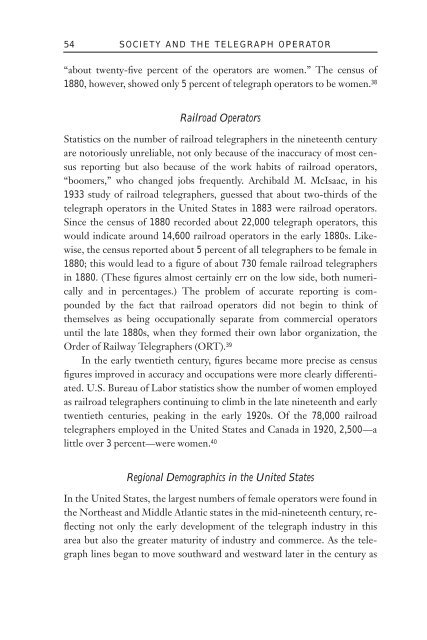My Sisters Telegraphic: Women in the Telegraph Office ... - Monoskop
My Sisters Telegraphic: Women in the Telegraph Office ... - Monoskop
My Sisters Telegraphic: Women in the Telegraph Office ... - Monoskop
Create successful ePaper yourself
Turn your PDF publications into a flip-book with our unique Google optimized e-Paper software.
54<br />
SOCIETY AND THE TELEGRAPH OPERATOR<br />
“about twenty-five percent of <strong>the</strong> operators are women.” The census of<br />
1880, however, showed only 5 percent of telegraph operators to be women. 38<br />
Railroad Operators<br />
Statistics on <strong>the</strong> number of railroad telegraphers <strong>in</strong> <strong>the</strong> n<strong>in</strong>eteenth century<br />
are notoriously unreliable, not only because of <strong>the</strong> <strong>in</strong>accuracy of most census<br />
report<strong>in</strong>g but also because of <strong>the</strong> work habits of railroad operators,<br />
“boomers,” who changed jobs frequently. Archibald M. McIsaac, <strong>in</strong> his<br />
1933 study of railroad telegraphers, guessed that about two-thirds of <strong>the</strong><br />
telegraph operators <strong>in</strong> <strong>the</strong> United States <strong>in</strong> 1883 were railroad operators.<br />
S<strong>in</strong>ce <strong>the</strong> census of 1880 recorded about 22,000 telegraph operators, this<br />
would <strong>in</strong>dicate around 14,600 railroad operators <strong>in</strong> <strong>the</strong> early 1880s. Likewise,<br />
<strong>the</strong> census reported about 5 percent of all telegraphers to be female <strong>in</strong><br />
1880; this would lead to a figure of about 730 female railroad telegraphers<br />
<strong>in</strong> 1880. (These figures almost certa<strong>in</strong>ly err on <strong>the</strong> low side, both numerically<br />
and <strong>in</strong> percentages.) The problem of accurate report<strong>in</strong>g is compounded<br />
by <strong>the</strong> fact that railroad operators did not beg<strong>in</strong> to th<strong>in</strong>k of<br />
<strong>the</strong>mselves as be<strong>in</strong>g occupationally separate from commercial operators<br />
until <strong>the</strong> late 1880s, when <strong>the</strong>y formed <strong>the</strong>ir own labor organization, <strong>the</strong><br />
Order of Railway <strong>Telegraph</strong>ers (ORT). 39<br />
In <strong>the</strong> early twentieth century, figures became more precise as census<br />
figures improved <strong>in</strong> accuracy and occupations were more clearly differentiated.<br />
U.S. Bureau of Labor statistics show <strong>the</strong> number of women employed<br />
as railroad telegraphers cont<strong>in</strong>u<strong>in</strong>g to climb <strong>in</strong> <strong>the</strong> late n<strong>in</strong>eteenth and early<br />
twentieth centuries, peak<strong>in</strong>g <strong>in</strong> <strong>the</strong> early 1920s. Of <strong>the</strong> 78,000 railroad<br />
telegraphers employed <strong>in</strong> <strong>the</strong> United States and Canada <strong>in</strong> 1920, 2,500—a<br />
little over 3 percent—were women. 40<br />
Regional Demographics <strong>in</strong> <strong>the</strong> United States<br />
In <strong>the</strong> United States, <strong>the</strong> largest numbers of female operators were found <strong>in</strong><br />
<strong>the</strong> Nor<strong>the</strong>ast and Middle Atlantic states <strong>in</strong> <strong>the</strong> mid-n<strong>in</strong>eteenth century, reflect<strong>in</strong>g<br />
not only <strong>the</strong> early development of <strong>the</strong> telegraph <strong>in</strong>dustry <strong>in</strong> this<br />
area but also <strong>the</strong> greater maturity of <strong>in</strong>dustry and commerce. As <strong>the</strong> telegraph<br />
l<strong>in</strong>es began to move southward and westward later <strong>in</strong> <strong>the</strong> century as

















